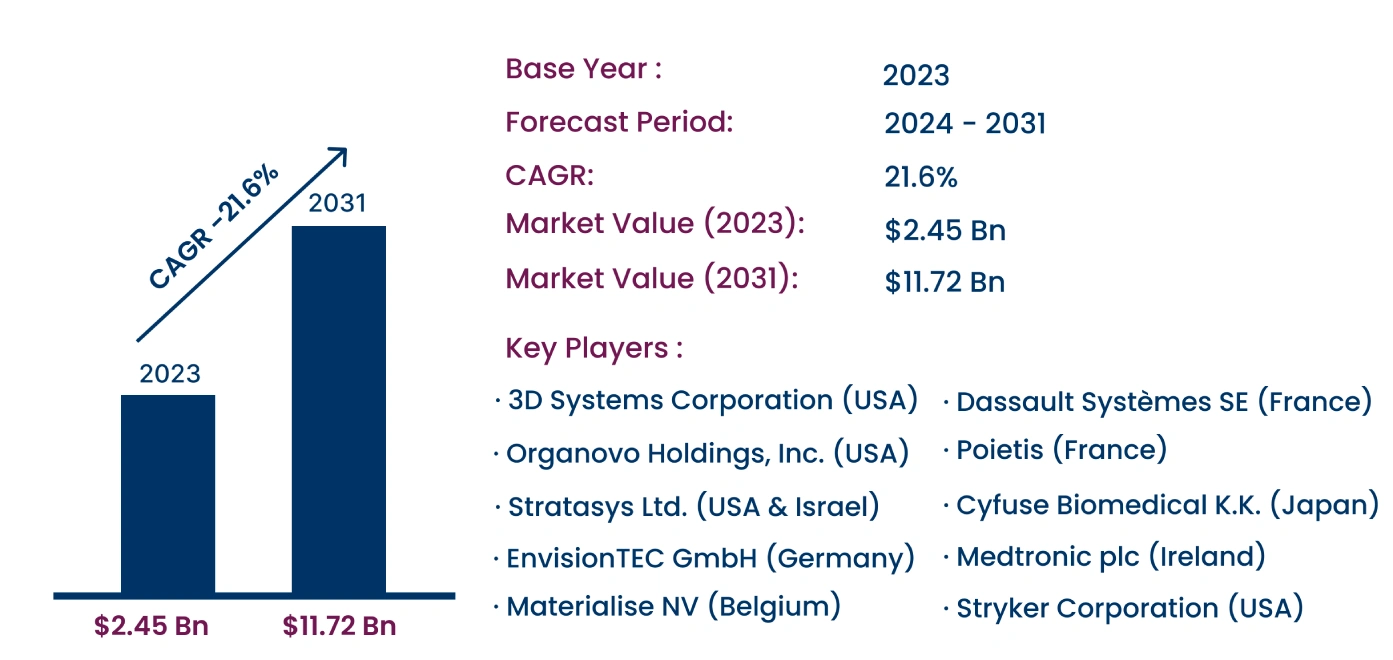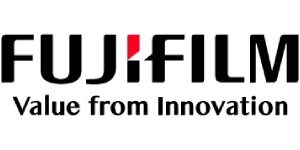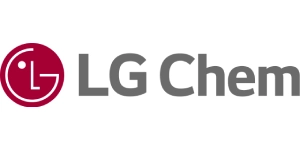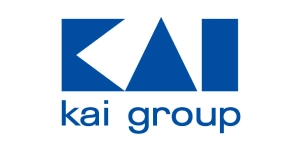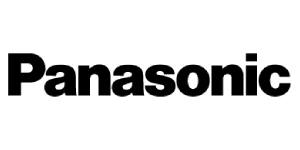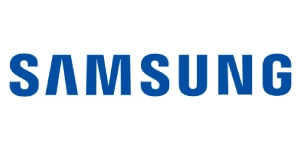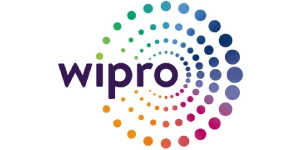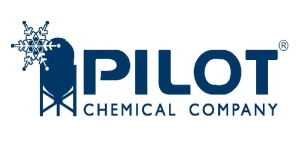Global 4D Printing in Healthcare Market to Reach USD 11.72 Billion by 2031 | CAGR of 21.6%
Category : Healthcare | Published Date : Nov 2024 | Type : Press Release
4D Printing in Healthcare Market Scope & Overview:
As per the Consegic Business Intelligence newly published report, the 4D Printing in Healthcare Market was valued at USD 2.45 Billion in 2023 and is projected to reach USD 11.72 Billion by 2031, growing at a CAGR of 21.6% from 2024 to 2031. 4D printing technology in healthcare involves using smart materials that adapt over time in response to stimuli such as heat, light, or moisture. This technology enables dynamic, responsive medical devices that adapt to changing physiological conditions, enhancing personalized treatments and improving clinical outcomes.
The report comprises the 4D Printing in Healthcare Market Share, Size & Industry Analysis, By Component (Equipment, Programmable Materials [Shape-Memory Materials, Hydrogels, Others], Software, Services), By Technology (Fused Deposition Modeling (FDM), PolyJet, Stereolithography (SLA), Selective Laser Sintering (SLS), Others), By Application (Medical Implants, Tissue Engineering, Organ Regeneration, Others), By End-User (Hospitals & Surgical Centers, Dental Clinics & Laboratories, Others), and By Region (North America, Europe, Asia-Pacific, Latin America, Middle East & Africa), and Forecast, 2024-2031.
The report contains detailed information on 4D Printing in Healthcare Market Trends, Opportunities, Value, Growth Rate, Segmentation, Geographical Coverage, Company Profile, In-depth Expert Analysis, Revenue Forecast, Competitive Landscape, Growth Factors, Restraints or Challenges, Environment & Regulatory Landscape, PESTLE Analysis, PORTER Analysis, Key Technology Landscape, Value Chain Analysis, and Cost Analysis.
Advancements in smart materials for dynamic biomedical applications are propelling market growth, while high development and production costs are acting as barriers.
Segmental Analysis :
By component, the market is segmented into equipment, programmable materials (shape-memory materials, hydrogels, others), software, and services.
- Programmable materials held the largest share in 2023, driven by the increasing use of shape-memory materials and hydrogels in medical implants and tissue engineering applications.
- Software is expected to grow at the fastest CAGR, fueled by the demand for advanced simulation and modeling tools that support complex 4D printing applications in custom implants and tissue engineering.
By technology, the market is segmented into fused deposition modeling (FDM), PolyJet, stereolithography (SLA), selective laser sintering (SLS), and others.
- Fused deposition modeling (FDM) dominated the market in 2023 due to its versatility, cost-effectiveness, and application in producing patient-specific devices.
- Selective laser sintering (SLS) is expected to register the highest CAGR, driven by its ability to print with a variety of materials, especially those required for high-strength, complex medical devices.
By application, the market is segmented into medical implants, tissue engineering, organ regeneration, and others.
- Medical implants held the largest market share in 2023, owing to the demand for adaptive, patient-specific implants that improve surgical outcomes.
- Tissue engineering is expected to grow at the fastest rate, as 4D printing facilitates the creation of dynamic scaffolds that enhance tissue regeneration and integration.
By end-user, the market is segmented into hospitals & surgical centers, dental clinics & laboratories, and others.
- Hospitals & surgical centers were the largest end-users in 2023, driven by the need for personalized medical solutions in complex surgical procedures.
- Dental clinics & laboratories are projected to grow at the fastest rate due to the rising demand for patient-specific, adaptive dental implants and orthodontic devices.
Based on regions, the global market is segmented into North America, Europe, Asia-Pacific, Middle East & Africa, and Latin America.
- North America led the market in 2023, supported by substantial investments in healthcare innovation and the early adoption of 4D printing technologies.
- Asia-Pacific is anticipated to grow at the fastest CAGR, driven by increasing healthcare investments and technological advancements in countries like China, Japan, and India.
| Report Attributes | Report Details |
| Study Timeline | 2018-2031 |
| Market Size in 2031 | USD 11.72 Billion |
| CAGR (2024-2031) | 21.6% |
| By Component | Equipment, Programmable Materials (Shape-Memory Materials, Hydrogels, Others), Software, Services |
| By Technology | Fused Deposition Modeling (FDM), PolyJet, Stereolithography (SLA), Selective Laser Sintering (SLS), Others |
| By Application | Medical Implants, Tissue Engineering, Organ Regeneration, Others |
| By End-User | Hospitals & Surgical Centers, Dental Clinics & Laboratories, Others |
| By Region | North America(U.S., Canada, Mexico) Europe(U.K., Germany, France, Spain, Italy, Russia, Benelux, Rest of Europe) APAC(China, South Korea, Japan, India, Australia, ASEAN, Rest of Asia-Pacific) Middle East & Africa(GCC, Turkey, South Africa, Rest of MEA) LATAM(Brazil, Argentina, Chile, Rest of LATAM) |
Top Key Players & Competitive Landscape :
The 4D printing in healthcare market is competitive, with major players focusing on product innovation, research and development, and partnerships to gain a competitive edge.
List of prominent players in the 4D Printing in Healthcare Industry:
- 3D Systems Corporation (USA)
- Organovo Holdings, Inc. (USA)
- Stratasys Ltd. (USA & Israel)
- EnvisionTEC GmbH (Germany)
- Materialise NV (Belgium)
- Dassault Systèmes SE (France)
- Poietis (France)
- Cyfuse Biomedical K.K. (Japan)
- Medtronic plc (Ireland)
- Stryker Corporation (USA)
Recent Industry Developments :
- In June 2023, Organovo Holdings, Inc. announced a collaboration with a leading academic institution to advance tissue engineering using 4D printing technologies.
- In March 2023, Materialise NV launched new software specifically designed to support dynamic 4D printed medical devices, enhancing precision and control in 4D printing.
